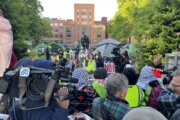FAIRFAX, Va. — Drivers on Interstate 66 inside the Capital Beltway will start paying tolls beginning in 2017, and now there is a better understanding of how the proposed timeline could play out.
Beginning in 2017, the Virginia Department of Transportation will charge a toll for solo drivers — projected peak charges of $7 during morning rush hour and $9 for the evening rush. Reverse commuters would pay between $1 and $2, according to VDOT.
Vehicles with at least two people inside would not be charged a toll, at least for now.
By 2020, VDOT plans to change from a HOV-2 format to a HOV-3 format, which means that vehicles with two passengers also would be subjected to a toll. Vehicles with three or more people would travel for free. The state transportation department projects the tolls could be as high as $8 in the morning and $3 evening, with reverse commuters paying $1. The change in format was outlined in the Constrained Long-Range Transportation Plan, which was reached with the Metropolitan Washington Council of Governments.
The conversion to HOV-3 also would apply to I-66 outside the Beltway, even though construction on the I-66 express lanes widening project would still be ongoing.
Coalition for Smarter Growth supports VDOT’s proposal.
“We believe that the package of solutions proposed by VDOT is the most cost-effective and efficient approach to addressing I-66 congestion as soon as possible, and for maximizing the number of people who can commute through the corridor during rush hour, while also guaranteeing a much more reliable trip for everyone,” says Stewart Schwartz, CSG executive director, in a news release.
Schwartz adds: “We’ve checked comparable pricing for Metro in the corridor and the peak tolls on the privately controlled [Interstates] 495 and 95 HOT lanes. We found that the potential highest tolls on I-66 inside the Beltway are competitive and reasonable. They’re also a much better deal that the public is receiving with the 495 and 95 HOT lanes, because public ownership allows us to invest the revenues in express buses and other transit services that will further improve conditions for those who drive.”
The new toll rates, however, have concerned some lawmakers, and could be a tough sell to commuters, especially those who already pay a toll on the Dulles Greenway and the Dulles Toll Road.
“The toll rate looks high,” says Sharon Bulova, chairwoman of the Fairfax County Board of Supervisors. “Tolls are not popular, but [they] unfortunately [are] a way of paying for transportation. It’s important that we have a conversation and continue to have a conversation with the community so that there is an understanding as to what options we have and what options we don’t have.”
Virginia Transportation Secretary Aubrey Layne says that many people won’t be driving the entire 10-mile stretch, so they would not end up paying the entire toll. But Deputy Transportation Secretary Nick Donohue reminded Fairfax County lawmakers on Friday that these tolls would be dynamic, like the express lanes, and could be more or less than these estimates, based on real-time traffic conditions.
“Those are the costs for running the whole 10 miles of the corridor, which in some ways doesn’t seem too bad to me, considering how bad traffic can be at certain times of the day,” says Arlington County Board Chairwoman Mary Hynes.
There are many opponents to the projects on I-66, both inside and outside the Beltway. Groups such as the 66 Alliance are upset that VDOT will eliminate the clean hybrid vehicle plate exception in 2017, which is now standard procedure when HOV lanes are turned into toll lanes. The group is also against converting HOV-2 to HOV-3.
Groups like Transform 66 Wisely oppose the widening of I-66 because of the impact it could have on homeowners. The group wants the state to invest more in Metro, VRE and commuter buses.
Virginia’s transportation agency has delayed widening I-66 inside the Beltway because of pressure mounted by those in Arlington and Falls Church to exhaust all other alternatives to relieve congestion.
Other lawmakers are frustrated with VDOT and say that the department isn’t widening I-66 soon enough, calling the wait unacceptable. Donohue told lawmakers Friday that VDOT would re-evaluate traffic conditions in the 2020s in order to determine whether widening inside the Beltway is warranted.
“We’re adding tolls without adding capacity, we’re adding tolls without a free option, and we’re setting this thing up to never have I-66 inside the Beltway be widened,” says Fairfax County Supervisor Pat Herrity. “I think those are all very serious problems.”
He adds: “Under the current plan, VDOT can control the level of congestion through tolling to the point that they’ll show there is no reason to widen the interstate. Then all the traffic congestion gets put onto our local roads. I don’t think that is right.”
Fairfax County lawmakers sent a letter to Layne with some suggestions on how to improve the project. Lawmakers are expected to discuss the issue Sept. 22.







